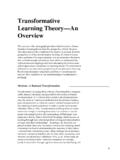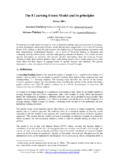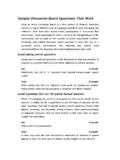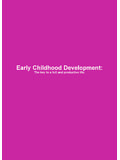Transcription of Expressions Learning Arts Academy
1 Expressions Learning arts Academy Academic Excellence Enhanced by the arts . 5408 13th Street Gainesville, FL 32608. Phone 352-373-5223 Fax 352-373-6327. Website: arts and Mathematics: An Integrated Approach to Teaching Justin DeLeo Second Grade Teacher 2002-03. Table of Contents arts and Mathematics: An Integrated Approach to Teaching ..2. Teaching Philosophy ..3. Concluding Thoughts ..4. Lesson One: The Immigrant Marketplace ..5. Lesson Two: Makin' Shapes, Writin' Riddles and Rhymes ..7. arts , Math, and More: Multiple Integrations ..9. Lesson One: Math in a Model ..9. Lesson Two: Fizzy Lifting Rockets ..12. Lesson Three: Singin' and Dancin' Through the Solar System.
2 14. arts and Mathematics: An Integrated Approach to Teaching Expressions Learning arts Academy Dissemination Grant 2002-2003. 1. arts and Mathematics: An Integrated Approach to Teaching There is no separation of mind and emotions; emotions, thinking, and Learning are all linked. (Eric Jensen, Teaching with the Brain in Mind, 1998). When thinking about arts and mathematics, people frequently view them as two separate domains. For a long time in education, mathematics was treated as a cognitive, thinking, rational, left-brain activity, while art was considered to be an affective, feeling, right- brain activity. This dichotomous view of arts and mathematics has greatly influenced the degree to which each has been taught separately from the other.
3 In truth, math and the arts share some inherent qualities that make them capable not only of integration, but of interdependence. There are many examples which demonstrate the interdependence of math and the arts . For instance, what would music be like without the mathematical elements of time, tempo, beat, and measure? How would a circle or square be drawn in an artistic composition without knowledge of geometric shapes? How can movement be choreographed to music without the counting of beats? How would the specifications of a set design be met without proper measuring tools? Both mathematics and the arts can be used to observe, describe, and imitate the natural world.
4 Indeed, it seems they were born of the very human desire to comprehend and re-create experience. Natural shapes are observed, drawn, measured, and erected into new structures. Detailed maps of human exploration mark where we have been and where we will go next. Magnificent machines are created that approximate or harness the powers of nature. Scientific studies support an integrated Learning environment. Brain research demonstrates that Learning activities which stimulate both the cognitive and affective areas of the mind are vital to its optimal development. The combined stimulation of these areas increases the amount of neural connections that are present throughout the brain, in effect allowing the brain itself to become more wholly integrated.
5 Learning mathematics and the arts together fosters this whole- brain development. There are additional benefits to teaching math and the arts in an integrated fashion. The hands-on nature of teaching art and math in combination helps build bridges between concrete and abstract mathematical ideas. Whether drawing circles to divide and cut out fractional parts, measuring out recipe ingredients, or writing out problem-solving steps in math journals, students are Learning more while using more of their minds. Moreover, integrating math with art meets the needs of diverse Learning styles and multiple intelligences. Lastly, the pleasant effects of artistic experiences may help kids to enjoy math more or to alleviate math anxiety.
6 arts and Mathematics: An Integrated Approach to Teaching Expressions Learning arts Academy Dissemination Grant 2002-2003. 2. Teaching Philosophy The pedagogical method employed by a teacher/school to a large degree reflects beliefs and experiences about teaching and Learning . As a part of a school with a curriculum rich in the arts , I feel fortunate to have beliefs that are aligned with school aims. In our school community, there are three underlying beliefs which fuel an enthusiasm for artistic Learning experiences. 1. The belief that a sound, standards-based, academic curriculum rich in the arts provides an environment of Learning that is effective, engaging, and enriching.
7 Children are engaged when they are being artistic. To engage in an artistic experience, a learner is required to think and to feel. Singing songs, playing recorders, memorizing scripts, performing plays, Learning dance routines are all a regular part of an arts -enhanced curriculum. Children are Learning through the arts . Comprehension, critical thinking skills, problem-solving, and expression are all strengthened through art. Standardized test scores consistently support the fact that the arts do not take away from key academic Learning , as argued by proponents of school budget cuts for the arts , but rather help to unlock its doors. 2. The belief that teaching should reflect current as well as time-tested methods of pedagogy.
8 Certain time-tested teaching techniques and tools are still used today because they are still effective and still have value to learners. For example, teaching children to sound out phonemes has for a long time been a strategy for reading. Likewise, the use of a chalkboard, and more recently a whiteboard, as a visual aid dates back to the colonial schoolhouses of America. An effective school utilizes what educational history has demonstrated to be vital to teaching. However, sticking to the tried-and-true . methods without remaining knowledgeable of current educational research is akin to the colorful expression If it ain't broke, don't fix it. Teaching is as dynamic as life itself, and teachers must strive to learn new things.
9 3. The belief that artistic experiences help to create a sense of well- being in an individual. ( Art makes you feel good! ). Not surprisingly, an arts -enhanced curriculum appeals to people with artistic interests and inclinations. Many of the students and staff at our school regularly engage in some form of artistic expression or discipline. Among us are actors, musicians, dancers, and visual artists. The benefits we have received through arts in our own lives strongly impact our belief in their educational value. arts and Mathematics: An Integrated Approach to Teaching Expressions Learning arts Academy Dissemination Grant 2002-2003. 3. However, the successful integration of the arts into the curriculum does not necessitate working in an arts -infused school, it simply takes the effort of teachers who know, and who care.
10 Even if teachers feel reluctant to use art or do not personally value it very much, most would agree that children learn best when they are enjoying what they are doing. Math can be a challenging, disinteresting, scary, or unpleasant for kids who struggle with, or are less oriented toward, mathematics. Integrating the arts into mathematical experiences brings a creative, enjoyable quality to the Learning and often makes it more comprehensible for those less inclined toward math. In the artistic process we are making, we are doing, we are creating something real. Likewise, it is the most realistic experiences which are essential to Learning and enjoying math. If one proceeds from the premise that artistic experiences significantly enhance all Learning , then it follows that students' understanding and appreciation for math will be deepened when it is presented to them in an artistic way.







